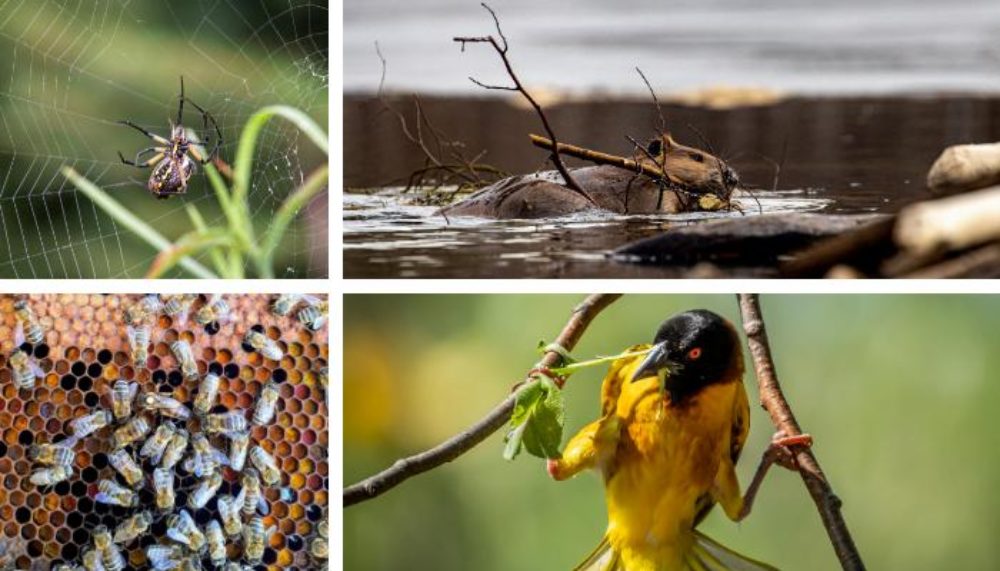
Nature’s remarkable engineers

At TEDI-London, we’re obsessed with engineering. Over the years, humans have learnt a great deal about the best ways to design and construct the built environment – thanks to past successes and failures, new technology, and exploring innovative ideas. But there’s also a lot to be learned from the most unexpected engineers hiding in plain sight; many other species have gotten to grips with some of the most fundamental engineering principles through their own instincts. Here’s a roundup of some of our favourite engineers from the animal kingdom.
Spiders
Most of us know from a young age that spiders create webs to capture prey, but have you ever given much thought to how complex these structures are?
As far as we know, the first spiders to produce silk came into existence almost 400 million years ago, although it wasn’t until later that they would use this ability to their advantage. Spider silk itself is incredibly strong; if you were to compare these thin silks to a steel beam of the same size, you would find that, in many cases, a silk strand can withstand more stress before breaking. However, because each strand of spider silk is 1000 times thinner than a human hair, its producer cannot rely on its strength alone to craft a web.
Spiders adopt some of the same engineering principles as us to construct their webs – and they’ve been doing so for far longer. Like suspension bridges, their webs need to be able to bear heavy loads and withstand harsh weather conditions. Plus, they need to be flexible enough to absorb the impact of insects as they fly into them – ensuring that they are captured rather than breaking through or bouncing back off.
Spiders achieve this by weaving together hundreds of silk threads between sturdy structures such as tree branches or even the furniture in your back garden. And if succeeding at that wasn’t impressive enough, spiders build their webs to start capturing food before they’re even finished; when a web is as little as 14% complete, its foundational structure and strength alone can effectively capture prey.
Beavers
If you think about it, beavers should be pretty easy prey; they’re heavy, strong-smelling, and their short legs make them slow movers on land. It’s thanks to their incredibly well-engineered dams that they’re able to keep away from predators such as mountain lions, bears, and wolves.
Beavers use their strong teeth to construct dams out of tree branches over bodies of water, before reinforcing them with grass, rocks, and mud. These structures help to slow the flow of water behind them, creating a pond that’s deep enough to remain unfrozen during the winter, and to deter land predators. It is in these ponds that beavers then build the ‘lodges’ that they live and store food in – accessing them via underwater tunnels.
Beavers are often referred to as a ‘keystone species’ – due to the benefits that their dams bring not only to themselves, but to wider ecosystems and even the planet. Beaver dams cause the water in rivers and streams to slow and spread into the surrounding area. This creates wetlands which are the perfect environment for thousands of other species to thrive, with wildlife experts estimating that more than 60% of threatened species rely on them for survival. What’s more, increased water retention around beaver dams allows for more plant life and vegetation to grow, removing CO2 from the atmosphere and reducing the impact of flash flooding. In other words, beavers are doing some of the work to fight climate change for us!
Bees
If you’ve ever come close enough to a beehive to observe it in detail, you may have noticed that it is made out of lots and lots of wax hexagons – all perfectly aligned. Bees create these ‘cells’ inside their homes to fulfil different purposes, with some used for food storage whilst others are used to raise young.
But why the hexagonal shape? Well, bees are often referred to as masterful mathematical design engineers because they’ve known for centuries that building hexagonally is the most efficient. Producing wax requires a significant amount of energy; for every pound of wax created, female worker bees must consume 6-8 pounds of honey. In fact, the British Bee Keepers Association estimates that forager bees visit around 30 million flowers for every pound of beeswax! Building honeycombs out of tightly packed hexagons as opposed to any other shape guarantees the maximum amount of storage space and strength using the least amount of wax.
It’s thanks to this strength and efficiency of materials that honeycombs have already inspired a number of engineers and architects to adopt the design in their own work, where its application is common in buildings, aerospace engineering, and even snowboard manufacturing!
Weavers
Many birds are nest-builders, but most of the time their nests serve a single purpose: to provide a place for eggs to hatch and for the young to reach maturity. Male weavers’ grass nests, however, are carefully designed to fulfil the additional purpose of attracting a mate in the first place, meaning that their nests must be more neatly woven than those of their competition. This also adds significant time pressure; female weavers won’t settle for old nests that have turned brown, so the males have only a matter of days to both build their nests and secure a mate.
The nests themselves are cleverly fashioned; weavers are the only birds with the ability to tie knots, allowing them to build nests that are suspended from branches rather than perched on top of them. Weavers are prey to various land species such as snakes and lizards, as well as other birds. The positioning of their intricate nests means that they can build their homes over bodies of water to deter land predators, whilst also creating entrances at the bottom of the structures to conceal them from predators flying above.
Weavers often include an additional fake entrance to their nests in an obvious location, to give predators the illusion that the structures are empty or abandoned. In some cases, snakes and other dangerous species take residence within these fake entrances, without even realising that they’re sharing a home with their prey! Weaver birds’ ability to achieve all of this with one structure made of grass demonstrates incredible design, architectural, and construction skill.
More Roundup articles


Engineering news roundup #10
